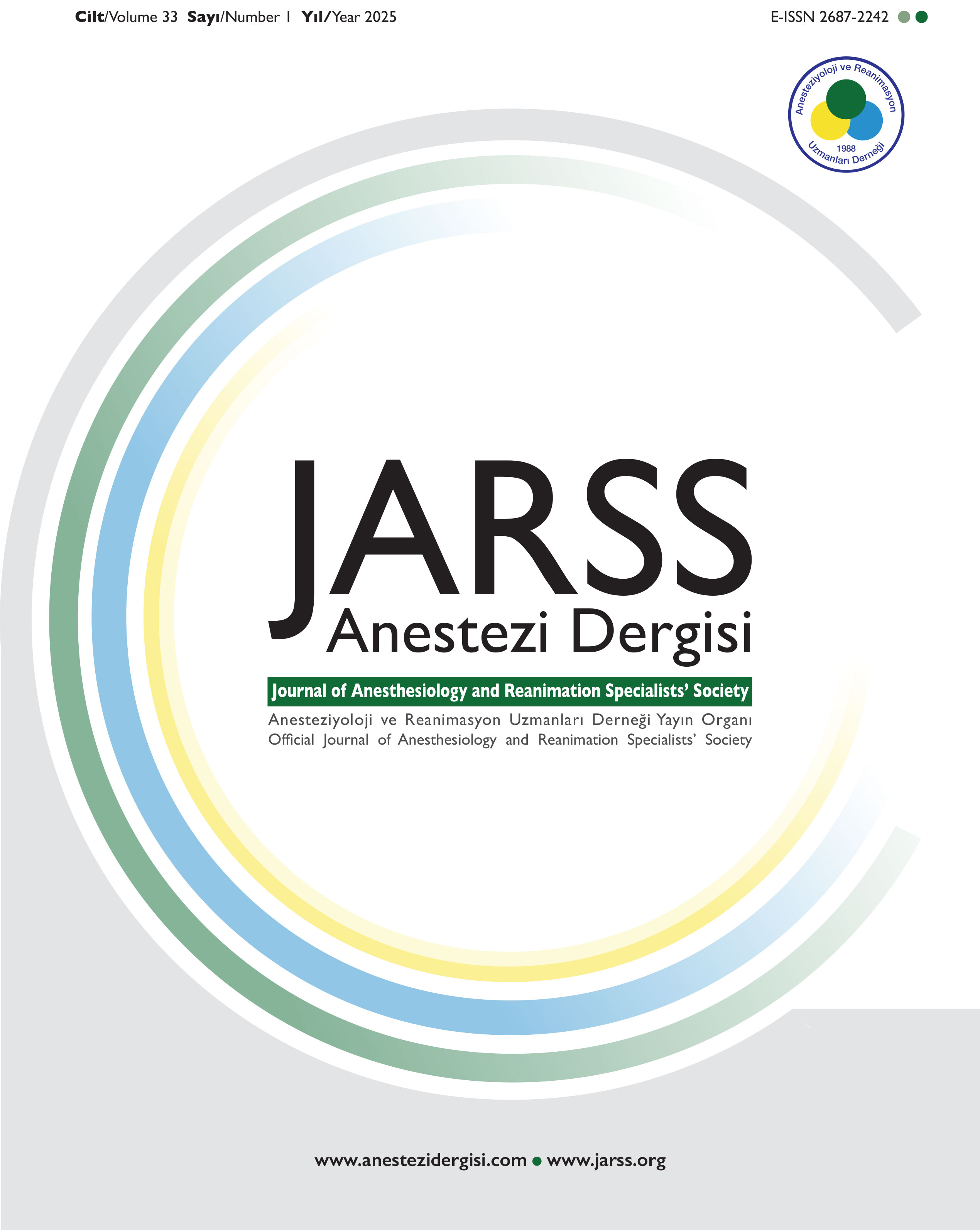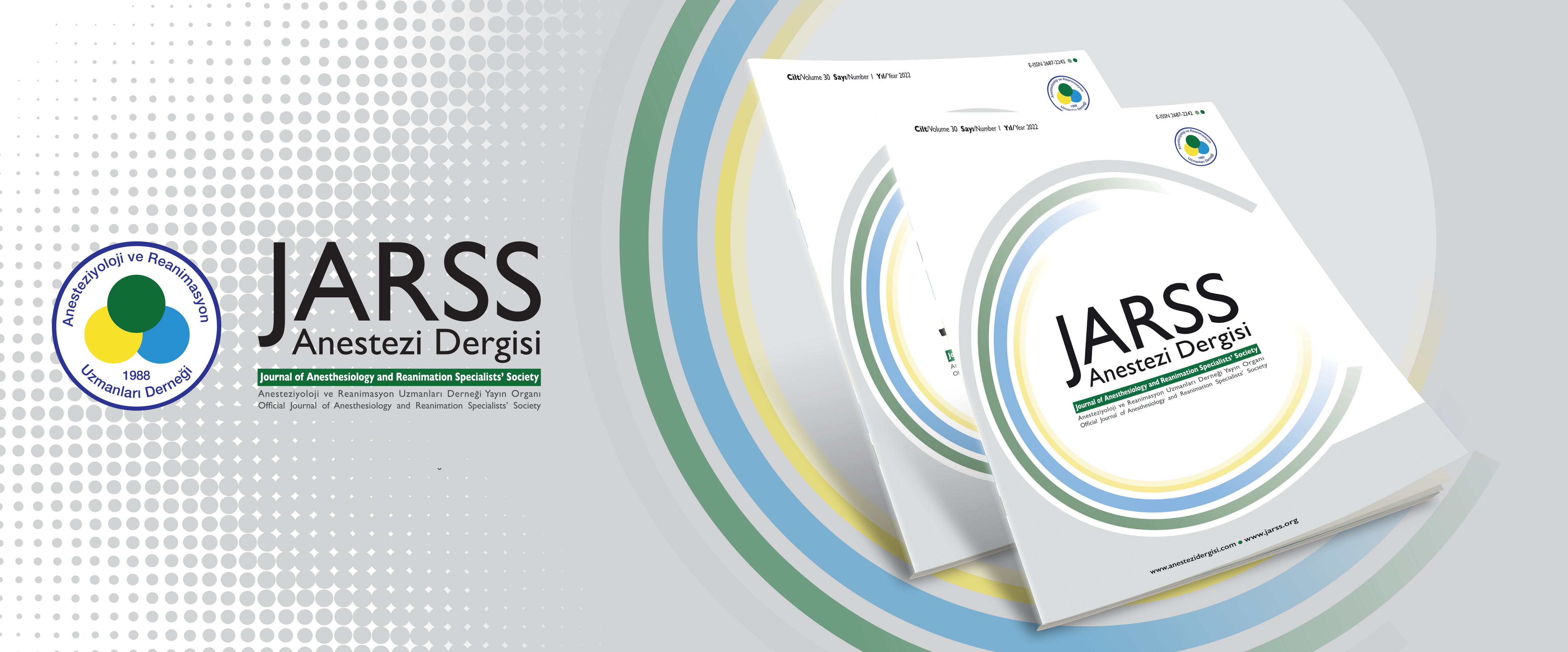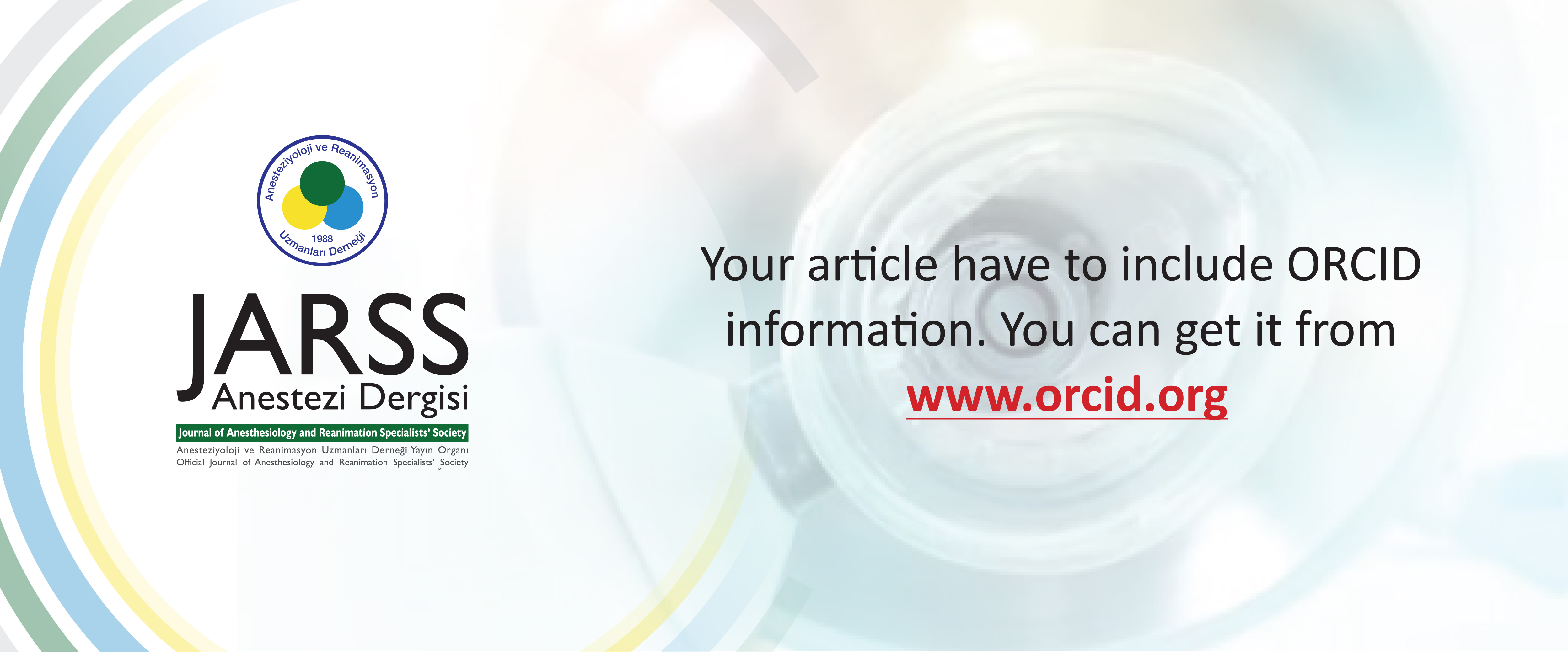Volume: 29 Issue: 4 - 2021
| 1. | Cover Page I (1481 accesses) |
| 2. | Advisory Board Pages II - IV (834 accesses) |
| 3. | Contents Pages V - VI (487 accesses) |
| REVIEW | |
| 4. | High Flow Nasal Oxygenation and Indications Ceyda Özhan Çaparlar, Bahar Sakızcı Uyar doi: 10.5222/jarss.2021.75547 Pages 211 - 218 (10959 accesses) High flow nasal oxygenation is increasingly being used as an alternative to standard oxygen therapy or noninvasive ventilation in the treatment of respiratory failure. In our country, its use has become widespread with the COVID-19 pandemic. The aim of this review is to discuss the advantages, disadvantages and indications of high flow nasal cannula in the light of the literature. |
| ORIGINAL RESEARCH | |
| 5. | A Prospective Randomized Study to Evaluate and Compare ILMA and Air-Q Intubating Laryngeal Airway Reema Wadhawa, Anisha Singh, Anju Bhalotra, Vanya Chugh doi: 10.5222/jarss.2021.59454 Pages 219 - 225 (962 accesses) Objective: Our aim was to evaluate the Air-Q intubating laryngeal airway (ILA) as a primary airway device and conduit for tracheal intubation and to compare it with the intubating laryngeal mask airway (ILMA) which is currently the ‘gold standard’ supraglottic airway used as a conduit for tracheal intubation. Methods: Eighty patients of either sex, aged 18-60 years scheduled for elective surgery were allocated into two groups. In Group I (n=40), the intubating laryngeal mask airway was used to secure the airway and in Group A (n=40), the Air-Q intubating laryngeal airway was used. Both devices were then compared and assessed as ventilation device and intubation conduit. Results: ILMA had a higher first attempt intubation success rate (95%) as compared to ILA (72.5%) but both devices were comparable with respect to ease of placement and total time required for intubation. Conclusion: Both ILMA and ILA were comparable as primary airway devices. The first attempt blind intubation success rate was significantly higher in Group I. |
| 6. | The Effect of Smartpilot® View, A New Decision Support System on Recovery and Anesthetic Consumption in Spinal Surgery: A Retrospective Study Gözde İnan, Gökçen Emmez, Hasan Kutluk Pampal, Zerrin Ozkose Satirlar doi: 10.5222/jarss.2021.66588 Pages 226 - 232 (890 accesses) Objective: Rapid and high-quality recovery from anesthesia following spinal surgeries is important for early neurological assessment. In this retrospective study, we aimed to compare effects of SPV-guided general anesthesia and BIS-guided standard anesthesia on recovery times and anesthetic consumption in patients who had undergone spinal surgery. Methods: Following ethics committee approval, records of the patients who underwent elective spinal surgery between November 2017-February 2018 were reviewed retrospectively. As a result of data scanning, patients were divided into two groups: SPV-guided (SPV) and BIS-guided standard anesthesia (Control). The demographics of the patients, anesthesia and surgery times, eye opening and extubation times, and amount of anesthetic drug consumed were compared between the two groups. Results: Totally 120 subjects were analyzed (SPV n=63, control n=57). Time taken for eye opening and extubation were 134.27±28.83 sec and 296.89±35.28 sec, 188.67±42.01 sec and 339.23±51.37 sec in SPV and control groups, respectively and both durations were significantly shorter in SPV group (p<0.001). End-tidal sevoflurane concentrations during maintenance of anesthesia were significantly lower in SPV group (p<0.05). Total remifentanil consumption was also significantly reduced in SPV group (p<0.001). Conclusion: By enabling for precise anesthetic titration during spinal surgery, SPV as a decision support device potentialy improved intraoperative decision-making, enabled faster recovery and reduced anesthetic consumption. |
| 7. | Comparison of Endotracheal Intubation Successes with Macintosh, Glidescope and Airtraq Laryngoscopes Tuna Ertürk, Hasan Ömür Özkan, Gökhan Inangil, Fuat Gürbüz, Sezai Özkan doi: 10.5222/jarss.2021.05025 Pages 233 - 242 (908 accesses) Objective: Successful airway management is the primary and most crucial step required for patient safety in anesthetic application. Due to the increase in the variety of materials used for ventilation and intubation in recent years, successful airway management has become more advantageous in difficult airway management. The development of Glidescope and Airtraq laryngoscopes are used as alternative laryngoscopy devices. The aim of the present prospective randomized study is to compare superiority of the success of endotracheal intubation performed with Macintosh, Glidescope and Airtraq laryngoscopes in terms of Cormack-Lehane laryngoscopic classification, intubation duration, number of attempts, and use of facilitating maneuvers required for intubation. Methods: Totally 180 patients over 18 years of age, in ASA I-II physiological risk group, who would undergo elective surgery were included in the study. The patients were randomly divided into three groups. Cormack-Lehane laryngoscopic classification, intubation duration, number of intubation attempts, facilitating maneuvers required for intubation, and complications related to intubation were recorded and compared in patients who were intubated with Macintosh laryngoscope in Group-A, Glidescope laryngoscope in Group-B, and Airtraq laryngoscope in Group-C. Results: It was found that demographic data were similar between groups. Cormack-Lehane laryngoscopic score, intubation duration, number of attempts and use of facilitating maneuver parameters of the Glidescope and Airtraq laryngoscope groups were similar and superior to the Macintosh group. In terms of intubation success rates and complications related to intubation, the frequency of the Macintosh laryngoscope group was similar to the Glidescope and Airtraq laryngoscope groups. Conclusion: According to the result of the study, it was concluded that Glidescope and Airtraq laryngoscopes provide a better view of glotis and ease intubation compared to Macintosh laryngoscope. However, we did not find any difference in intubation success and complication rates between the groups. |
| 8. | Comparison of Desflurane and Sevoflurane on Myocardial Protection and Inflammation in Coronary Artery Bypass Surgery Alper Tunga Dogan, Ömer Kurtipek doi: 10.5222/jarss.2021.29981 Pages 243 - 253 (856 accesses) Objective: The aim of this study is, in terms of intraoperative myocardial ischemia, to compare the effects of desflurane with sevoflurane to ST-segment changes, cardiac enzyme and tumour necrosis factor-α (TNF-α) values in patients undergoing coronary artery bypass grefting surgery (CABGS). Methods: Thirty-one patients undergoing elective CABGS were randomly allocated into two groups; in Group-D desflurane and in Group-S sevoflurane was administered. Hemodynamic parameters, ST-segment changes, cardiac output and minimum alveolar concentrations (MAC) were recorded. Blood samples were drawn for cardiac enzyme and TNF-α assay before induction of anesthesia and at intra- and postoperative time periods. Results: Hemodynamic parameters, ST-segment changes, and cardiac output were similar between the two groups. Creatine kinase-MB and troponin-T values were similar between the groups. In Group-D TNF-α levels at the post-operative 2nd hour was found significantly lower than Group-S. The skin closure and postoperative 24th hour TNF-α values were lower than Group-D. Conclusion: During the anesthesia for CABGS desflurane and sevoflurane protect the myocardium identically that can be detected by ST-segment changes, creatine kinase-MB and troponin-T levels. In the early postoperative period desflurane and in the late postoperative period sevoflurane further suppresses the inflammation response indicated by TNF-α levels. We think that desflurane can be used as a safe volatile anesthetic agent in coronary artery bypass grafting surgery because of its stable hemodynamic and myocardial protection and anti-inflammatory effects. |
| 9. | Comparison of Rebound Pain and Postoperative Tramadol Requirement in Patients Who Had Femoral Nerve Block or Adductor Canal Block for Pain After Total Knee Arthroplasty Yusuf Özgüner, Alp Alptekin doi: 10.5222/jarss.2021.60590 Pages 254 - 262 (1559 accesses) Objective: It was aimed to compare the rebound pain and postoperative tramadol requirement in patients who underwent femoral nerve or adductor canal block after total knee replacement surgery under general anesthesia. Methods: Fifty ASA I-III patients, 18-80 years of age, who underwent total knee replacement surgery and underwent these blocks after induction of anesthesia for postoperative analgesia, were examined in the postoperative period. The patients were divided into 2 groups as FNB (femoral nerve block) and ACB (adductor canal block) (Group F and Group AC). Patient controlled analgesia (PCA) was applied to all patients with intravenous tramadol as a rescue analgesic. 75 mg diclofenac sodium was administered intramuscularly for additional analgesic requirement. Postoperative pain scores, tramadol consumption, additional analgesic requirement, incidence of rebound pain and other complications were recorded. Visual Analogue Scale (VAS) and Bromage scales were used to monitor pain and motor weakness in the postoperative period. The data were analyzed with the SPSS 20.0 statistical program. Results: Three of the 7 patients with rebound pain were in the femoral block group, while the other 4 patients were in the adductor canal block group. Rebound pain durations were followed as 50, 60, 120 and 60, 60, 90, 110 minutes, in group F and group AK, respectively. The frequency and duration of rebound pain were similar. It was found that postoperative pain scores at 0. 2. 4. and 8. hours were statistically significantly lower in patients who underwent femoral block than those who received adductor canal block. Bromage scores at 0, 2 and 4 hours in the femoral block group were statistically lower than the adductor canal block group. Tramadol consumption with PCA was significantly lower in the femoral block group than in the adductor block group. When total tramadol consumption and additional analgesic requirement were compared with postoperative complications, no statistically significant difference was found between the two groups. Patient satisfaction scores in both groups were similar. Conclusion: The frequency and duration of rebound pain in both groups were similar. We found that femoral block provides more effective analgesia in the first 8 hours compared to adductor canal block. Request to use PCA was significantly lower in the femoral block group. There was no statistically significant difference between postoperative complications and additional analgesic needs. |
| 10. | Analgesic Efficacy and Safety of Dexmedetomidine as an Adjuvant to Caudal Levobupivacaine for Infraumbilical Surgeries in Children Amanjot Singh, Kewal Krishan Gupta, Amarjeet Kaur, Haramritpal Kaur doi: 10.5222/jarss.2021.84756 Pages 263 - 269 (1388 accesses) Objective: Postoperative pain management is becoming an integral part of anaesthesia care. Single shot caudal block is a common technique for paediatric analgesia but with the disadvantage of short duration of action. Several adjuvants have been used to prolong the duration of caudal analgesia. So we designed this study using dexmedetomidine as an adjuvant with levobupicaine for caudal block to assess analgesic efficacy, duration of postoperative analgesia, hemodynamic stability and any adverse effects in children. Methods: After getting approval by Institutional Ethical Committee and written informed consent from parents, this prospective, double blind trial was carried on 80 children aged between 1 to 12 years scheduled for elective subumbilical surgeries that were allocated randomly into one of two groups. Children in Group A received 0.25% levobupivacaine 1 mL kg-1 body weight with 0.5 mL normal saline and in Group B received 0.25% levobupivacaine 1 mL kg-1 body weight with dexmedetomidine 1 mL kg-1 in 0.5 mL normal saline as caudal drug mixture. Results: The mean duration of analgesia in Group A was 324.±55.6 min and in Group B was 678±170.9 min which was statistically significant (p<0.001). The total analgesic requirement over 24 hours and the mean pain score was also lesser in group B. Conclusion: Dexmedetomidine in doses of 1 μg kg-1 as an adjuvant to 0.25% levobupivacaine for caudal block in pediatric infraumbilical surgeries provides significant prolonged postoperative analgesia and better quality of sleep without any increase in adverse effects. |
| 11. | Effect of Anesthesia Type on Mortality in Endovascular Aortic Repair Hülya Kaşıkara, Eşref Kemal Erdoğan, Fulya Eser, Fatma Kavak Akelma doi: 10.5222/jarss.2021.64326 Pages 270 - 278 (744 accesses) Objective: In aortic aneurysms, endovascular methods were first applied under general anesthesia. The use of local and regional anesthesia methods were gradually increased in the following period. The aim of this study is to evaluate the effects of anesthesia methods used in patients who underwent elective and emergency endovascular aortic reconstruction between 2015-2018 on mortality, postoperative complications, intensive care and hospitalization. Methods: The data of patients who underwent endovascular aortic repair between the years 2015 and 2018 were reviewed retrospectively. Demographic data of the patients, ASA score, emergency/elective operation status, type and localization of aortic pathology, preferred anesthesia method, duration of anesthesia, extubation/intubation from the operation, length of stay in hospital and intensive care unit were recorded. The effect of the obtained data on 30-day mortality was investigated. Results: Data from 70 patients were analyzed. There was no significant relationship between the age of the patients, the duration of the intervention, the anesthesia method applied, the intubation or extubation situation following the procedure, the length of stay in the hospital and intensive care unit, and mortality. Mortality also increased significantly in patients with coronary artery disease (p=0.044). It was found that mortality increased significantly in patients who were operated under emergency conditions (p=0.002). Conclusion: Mortality rates are increasing in patients who are operated under emergency conditions for endovascular aortic repair. Different types of anesthesia method do not affect mortality. For this reason, we believe that the most appropriate anesthesia method should be preferred for each patient. |
| CASE REPORT | |
| 12. | Anesthetic Management of Three Parturients With von Willebrand Disease Gozde İnan, Naciye Türk Ozterlemez, Melis Altuğ, Dudu Berrin Günaydin doi: 10.5222/jarss.2021.60490 Pages 279 - 282 (1179 accesses) Von Willebrand Disease (vWD) cases with bleeding symptoms can be admitted repetitively and anesthesia is required for minor or major surgery. We aimed to present anesthetic management of three patients with vWD and their post-operative follow up by discussing it in accordance with the literature. Any patient with vWD scheduled for surgery and/or delivery needs careful antenatal evaluation and long lasting postpartum follow up in a tertiary care center by multidisciplinary approach where blood and/or factor concentrates readily available. |
| 13. | Bilateral Ultrasound-Guided Rectus Sheath Block for Anesthesia of Midline Laparotomy Zeynep Ersoy, Mesher Ensarioglu, Coşkun Araz doi: 10.5222/jarss.2021.76588 Pages 283 - 286 (1251 accesses) Tracheoesophageal fistula (TEF) may develop in 5% to 15% of patients with esophageal cancer. This may cause complications such as aspiration, bleeding, perforation, migration and pneumonia during general anesthesia and care should be taken in anesthesia management. In this case report, the perianesthetic management of bilateral rectus sheet block (RSB) application as the primary anesthesia technique for midline laparotomy in a patient with malignant TEF and pneumonia is discussed. |
| 14. | Author Index Page E1 (399 accesses) Abstract | |

















